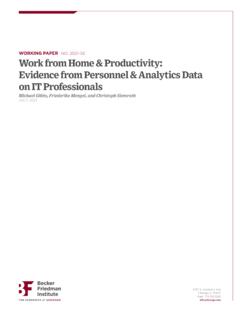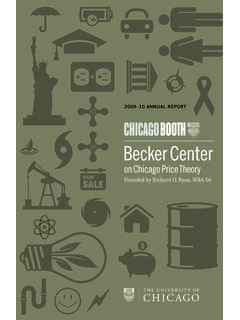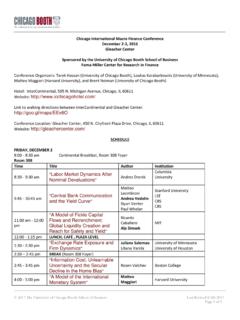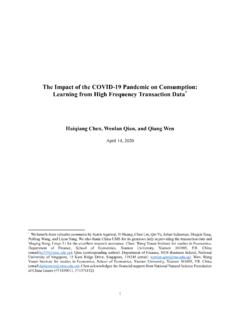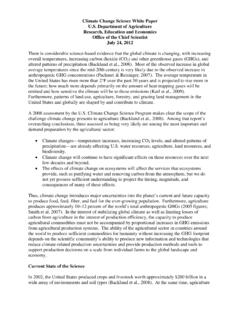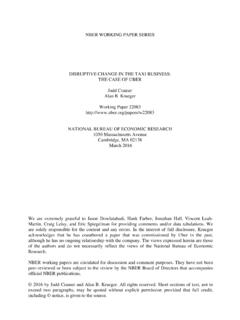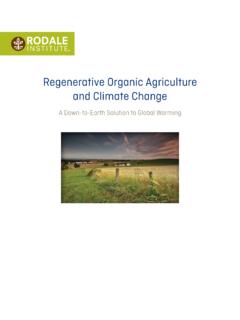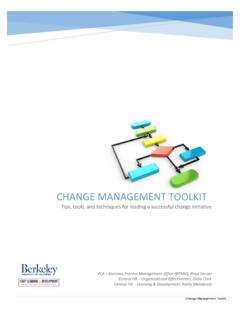Transcription of WORKING PAPER 43 Impact of the COVID-19 Crisis on …
1 5757 S. University Ave. Chicago, IL 60637 Main: PAPER NO. 2020-143 Impact of the COVID-19 Crisis on Family Dynamics in Economically Vulnerable HouseholdsAriel Kalil, Susan Mayer, and Rohen ShahOCTOBER 2020 COVID-19 and Family Dynamics 1 Impact of the COVID-19 Crisis on family dynamics in economically vulnerable households Ariel Kalil Susan Mayer Rohen Shah Harris School of Public Policy Studies University of Chicago October 2020 Acknowledgements: The COVID-19 study conducted in the spring of 2020 was funded by the Becker Friedman Institute at the University of Chicago. Funding for the original studies from which the COVID-19 sample was drawn was provided by the Valhalla Charitable Foundation, the Overdeck Family Foundation, Heising-Simons Foundation, Robert Foundation, and Paul M.
2 Angell Family Foundation. Ana Arellano Jimenez and Paula Rusca provided invaluable research assistance. COVID-19 and Family Dynamics 2 Abstract The COVID-19 Crisis and its reverberations resulted in levels of economic distress unprecedented since the 1930s. But COVID was a seismic social shock even for families that lost no income, due at least in part to abrupt school closures and the widespread threat of illness and death. The COVID-19 Crisis will not affect all families equally, but may cause particular harm to children of low-income and less-educated parents and for preschool age children, who are especially sensitive to developmental inputs. We surveyed 572 low income families with preschool-age children in Chicago to understand family dynamics following the economic and social restrictions imposed by the pandemic.
3 We separately examine the associations between economic hardship, exposure to the virus, and pandemic-induced increases in childcare time on parental mental health and stress, parent-child interaction, and children s adjustment. We find both positive and negative effects: Parental job and income losses are strongly associated with parents depressive symptoms, stress, diminished sense of hope, and negative interactions with children. However, these ill effects do not occur for parents who lose jobs but do not experience concomitant income losses. In fact, job losses without income losses are associated with more positive parent-child interactions. Parents exposure to COVID-19 is associated with less positive parent-child interactions and more child behavior problems.
4 In contrast, parents who report spending substantially more time in childcare as a consequence of the pandemic report more positive parent-child interaction. We discuss the implications of these results for policy and practice. COVID-19 and Family Dynamics 3 Introduction The coronavirus pandemic represents the biggest shock to the American economy since the Great Depression. Following the imposition of stay at home orders across the country, the labor market collapsed over roughly two weeks in late March and early April. But COVID-19 was a seismic social shock even for families that lost no income, due at least in part to abrupt school closures and the widespread threat of illness and death. In many instances, the school closures substantially increased the time that parents, especially mothers, spend with their children (Baxter et al.)
5 , 2020; Calarco et al., 2020; Sevilla & Smith, 2020). For schoolchildren, school closures and learning interruptions could threaten children s learning and adjustment (Kuhfeld et al., 2020) but the effects will depend on the quantity and quality of parent-child interaction at home. Low income children may be at greater risk for learning losses and behavioral stress than high income children given average pre-pandemic differences in parent engagement in children s learning (Kalil et al., 2012). The novel coronavirus has been more prevalent among low income families resulting in much more anxiety in these families about threats to their health and well-being. The changes arising from the novel coronavirus can also have a direct effect on the level of distress parents and children experience arising from social isolation due to stay at home orders, including physical and social distance from their friends and schools and changes to their usual daily routines.
6 Parental and child well-being may be diminished by concerns about their own and their family s health as a consequence of exposure to the virus itself. The COVID-19 Crisis will not affect all families equally, but may cause particular harm to children of low-income and less-educated parents, who tend to have lower academic and socio-emotional skills compared to higher income or more educated parents already (Attanasio et al., COVID-19 and Family Dynamics 4 2020) and for preschool age children, who are especially sensitive to developmental inputs that shape lifelong attainment and achievement (Duncan & Magnuson, 2011). In this PAPER we compare the relative importance of pandemic-induced economic hardships ( job and income loss and inability to make ends meet) versus pandemic-induced social conditions ( , exposure to the virus and pandemic-induced increases in child care time) as they relate to parental mental health and stress, parent-child interactions, and children s behavioral adjustment.
7 Background The economic and social shifts arising from COVID-19 represent key forces capable of shaping the future life courses of American children. The associations between parental economic stress, parent mental health and behavior, and children s socio-emotional adjustment in the short and long term are well documented (Del Boca et al., 2014; Fiorini & Keane, 2014; Hsin & Felfe, 2014; Jackson et al., 2000; Kalil & Ryan, 2020). Existing research on the relationship between the COVID-19 pandemic and family life has largely focused on its economic and mental health impacts (Calarco et al., 2020; Gassman-Pines et al., 2020). The COVID-19 pandemic and the policy response to it including stay-at-home orders, new regulations for essential workers, and school closures may create a stressful environment for families through many channels: worries about health; pressures related to going to work, WORKING from home or the potential of job loss and consequently income loss; the need to home-school children, and other possible consequences of living through this pandemic.
8 These stresses could diminish the quality of parent-child interactions (Kalil, 2013), which may in turn amplify socio-emotional or behavioral problems in children. COVID-19 and Family Dynamics 5 On the other hand, the effects of the pandemic need not be uniformly negative (note, however, that we consider the potential effects of exposure to the virus itself to be uniformly negative). One unique feature of the economic policy response was the federal stimulus funds targeting lower income households and delivered to families in the late spring. Unemployment insurance was expanded in unprecedented ways during the current COVID-19 pandemic. Indeed, large numbers of families experiencing job losses actually enjoyed higher incomes during their period of unemployment as compared to the pre-pandemic time during which they were employed (Ganong et al.)
9 , 2020). Thus, for some families, this period was tantamount to a paid family leave. The rapid and generous early federal response to supporting the unemployed are a unique feature of the COVID-19 pandemic, distinguishing it from prior periods of high job loss such as the Great Recession of 2008. Parent time (especially mothers time) in childcare has increased in the wake of school closings and stay at home orders (Baxter et al., 2020; Calarco et al., 2020; Sevilla & Smith, 2020). The effects of an increase in time with children are uncertain. On one hand, caring for young children while isolated at home and potentially also juggling employment may be stressful for at least some mothers. However, nationally-representative data show that the time that parents spend in child care provides the most feelings of positive affect and meaning compared to the time that parents spend engaged in any other activity and that this is especially true for low-income parents (Kalil et al.
10 , 2019). Calarco and colleagues (2020) surveyed 139 mothers from a range of income levels during the spring of 2020, finding that on average mothers who have greatly increased the time they spend caring for their children during the pandemic have disproportionately experienced substantial increases in stress, anxiety, and frustrations with their children. However, this was true primarily for mothers who held themselves to a high standard of COVID-19 and Family Dynamics 6 intensive parenting. Other mothers in their sample did not experience increased time with their children as a substantial source of stress and indeed even characterized the increased parenting time as a source of joy in otherwise difficult times.
